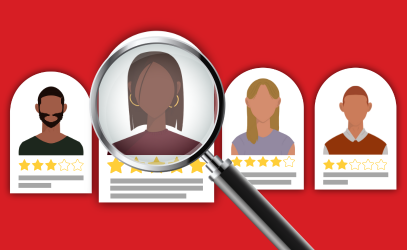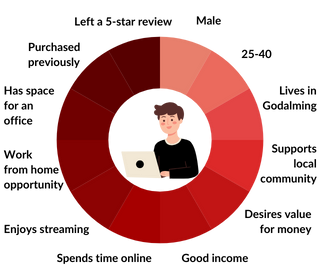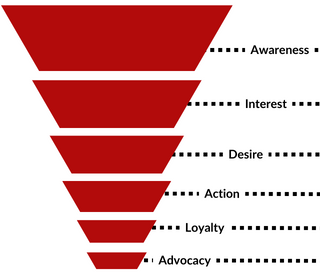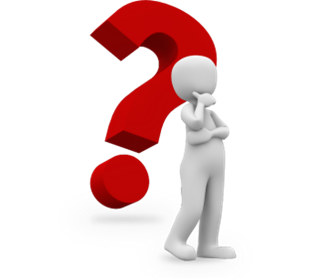The Importance of Understanding Your Customer Persona

As marketers ourselves, we know that targeting according to KPIs and data analysis alone isn’t enough to get meaningful engagement — that’s the job of a customer persona.
Not sure what that is? Or maybe not sure how it comes into play for your business? Follow along and find out!
Want to skip to a section?
Why is it important to know your customer persona?
Segmentation, targeting, and positioning.
The benefits of target marketing.
How to identify your customer persona.
Key elements to keep track of.
How often should you review your customer persona?
What is a Customer Persona?
A customer persona is a complete detailed breakdown of your ideal buyer.
Instead of being a broad overview of your target audience, it pins down and fine-tunes all of the possible identifiers of your dream customer. Every business will have one, no matter how ‘mass’ or ‘mainstream’ you think your product is. There is an ideal buyer out there for you, and identifying them is your first step to success.
The more specified and niche you can make your customer persona, the more it will be of aid to you. For example, just specifying a ‘man who likes computers’ is far less beneficial than having a complete rundown of all of their ideal demographics and psychographics. Let’s say you were a small-scale retailer of technologies, your ideal customer persona could look something like this:
- Male.
- Aged between 25 and 40.
- Lives in Godalming.
- Supports his local community.
- Desires value for money.
- Has a good income but very little outgoings (no kids).
- Spends his spare time online.
- Enjoys streaming music, TV shows and movies.
- Has had a ‘work-from-home’ opportunity arise at work.
- Has spare space in his home for an office set-up.
- Has visited the store and purchased with you previously.
- Previously left a 5-star review.
- And so on….

Obviously, this is a hypothetical customer persona. With the power of cookies and online tracking today you will have a lot of this information at your fingertips, niche and bespoke to your business. We will talk you through the specificities and what to crack down on later in this blog, but for now, you get the gist – the more concise you can get your profile, the more likely you are to be able to be in the right place, at the right time, for the right customer.
So I guess you want to know, why should you develop a customer persona?
Why is it important to know your Customer Persona?
In simple terms, a better understanding of who exactly you are trying to attract means you can focus your marketing efforts in the right place. Too many businesses these days are trying to get everyone’s attention with a single ad, social post, or blog. Whilst that can work for hugely dominant companies who operate as the monopoly in their industry, any business with a level of competition is losing out on their ideal buyers - not to mention the wasted marketing funds, due to finance being pushed out in all the wrong directions.
The simple problem with trying to reach everyone at once is that you run the risk of resonating with… no one.
People like to be spoken to. They like to feel seen. They need to feel like what you are offering is tailored for them.

Put yourself in a customer's shoes. If you saw an Instagram post, captioned ‘Visit our UK clothing store at some point this week!’ does it pull you in? Is it enough to convert you? Probably not. But let’s say you are a businessman, who loves cycling and lives in Surrey, would this pull you in?
‘Come down to Godalming town to visit our men's cycling-wear pop-up shop. Prepare yourself for a Saturday reset after your busy week, and pick up all of your bike equipment for a weekend of fun!’
You feel like it is made for you – they have spoken to you. It’s as simple as that.
By learning your customers, their habits, interests, jobs and desires – anything you can – you are able to talk directly to them, create a sense of parasocial intimacy, and you have pulled them in in a way your competitors haven’t. Then what?

You have gained loyal customers. Awareness, interest, desire, and action are all easily achievable through targeted marketing. All you have to do then is keep on talking to them, nurture their desire, and just like that, you have easily retainable customers.
You don’t want to over-target, however. Over-targeting is when you narrow focus onto a niche so much, that other audience segments feel excluded. You still want to invite everyone to be a part of your customer base, so it can grow as much as possible, expand, and diversify - but honing in on your ideal customer pulls at the most ready-to-convert onlookers. By no means do you ignore anybody who doesn’t fit into your very bespoke category of ‘buyer persona’, but having it down as a template creates a targeting guide, so you can be where you need to be, for the right people.
What does this mean?
Segmentation, Targeting and Positioning (STP)
Segmentation, targeting, and positioning (STP) is a 3-step flow that narrates the process of moving from market research to the final release of marketing materials.
Segmentation: Dividing up the general public into audience ‘segments’. In the instance of building a customer persona, your audience ‘segment’ is the profile you put together of your dream buyer.
Targeting: Using the appropriate language, ideologies, materials, and imagery to appeal to this specific segment. This is where a deep understanding of your buyer persona is so crucial, as the more focused your message can be, the more likely it is to resonate with them.
Positioning: Ensuring your marketing materials are visible in the right places to attract these audiences. This refers to both online and in-person. For example, choosing your social channel of focus is dependent on how many of your ideal customers are going to be present on that platform, while choosing the right storefront ad may come down to what facilities are nearby that may attract your target persona to be in the right place to see you.



Let’s follow an example.
This is Wendy. She owns an art store on Godalming High Street, and her buyer persona looks a little bit like this.
- Female
- Aged between 24-40
- Has disposable income
- Owns their own home
- Loves astrology, star signs, nature
- Single
- Appreciates art and culture
- Prioritises quality>price
If you were Wendy, would you show off your artwork on…
- Pinterest?
- Twitter (X)?

The answer would be Pinterest. Pinterest is a social platform centred around the appreciation of art, design, culture and aesthetics. It is strongly dominated by young female users. The important thing here is that this does not make Twitter (X) redundant. It may be that by showcasing her artwork on Twitter (X) she facilitates the needs of a secondary target segment – this could still be business potential for Wendy, however, her priority should be Pinterest, where she knows her easiest-to-convert user base is.
You would then fine-tune what time you want to upload your ‘pins’, if that is the only channel you want to use, what keywords you would attach to your images etc. – all with the best interests of your customer persona at heart.
Your business will already be following the STP 3-step flow, however it may just not be niche and specific, or even thought out enough. The value of understanding your customer persona here is unmatched – it gives you a whole host of competitive advantages and really should be utilised to maximise business success.
The benefits of Target Marketing
- Attract high-quality leads. The closer you get to your customer persona, the more ready they are to buy. This means you will be in front of far more ready-to-convert customers, positioning them at high value for your business.
- Allows you to stand out. The internet, in particular, is oversaturated with like-for-like businesses. Having a unique tone of voice, intended for your customer persona, will position you to stand out above the rest. As we said, speak to them, and they will notice you.
- Reduced wasted resources. Marketing campaigns can be both time and cost-extensive – but even more so when you are trying to appeal to everyone. Focusing your efforts, mostly, on just one target segment (customer persona) has the potential to yield a higher ROI on your campaign, and therefore be more cost and time-effective.
- Connect directly with one segment. Lots of people in today's online age crave community. Attracting like-minded individuals through target marketing, aimed at your buyer persona, brings a host of people to one place. This will build a team of advocates, sharing the love for your products/services, and raising brand awareness for you.
- Better engagement. As we said, consumers love to feel seen. Even in something as simple as a social post, using your tone of voice in a way that appeals will resonate with them. This will, in turn, encourage likes, follows, comments, clicks, shares and so forth – boosting your brand up in position in algorithms, visibility, and awareness.
How to identify your customer persona
Now that you understand why a customer persona is so important for your marketing strategy today, here is a list of questions that you should never leave out of a customer persona profile. A start is better than nothing, and the more information you can get the better, but in our experience, the way you answer these questions is a great starting point to yield results.
- What is their age?
- What is their gender identity?
- Where do they live?
- Are they a parent/carer/guardian?
- Have they shopped with you before?
- Are they interested in XYZ?
- What is their annual income?
- What are their priorities when it comes to products and services? Quality or Price?
- What are their top 3 hobbies?
- What are their top 3 interests?
- Do their friends have similar interests?
- What are their desires in the next 5-10 years?
- What stage of the sales funnel are they at?
The general key elements of this profile you need to keep on top of are:
- Age
- Household location
- Hobbies and interests
- Income
- Priorities when making a purchase
- Stage of the sales funnel

It is important to remember that everything is industry and scale-dependent. It may be that as you grow from a local business and globalise, your ideal customer will change from being in Surrey, to somewhere more expansive such as the US. If you feel as though your customer persona has changed at any point, these are the first 6 categories I would recommend reviewing. This is because these define the template for your tone of voice and marketing materials, and therefore if you are following old habits, with a new segment, you will lose the power of target marketing, and stop reaping rewards.
So you may be wondering…
How often should you review your customer persona?
As frequently as possible is ideal, however, there are a few key points that we would mark as definite review dates. First and foremost, before the start of any new campaign - reviewing your target persona should be your first point of call here, so that no time in the planning, creating, or implementation stages goes to waste on targeting the wrong segment. Secondly, a review is necessary as trends develop; In the online age, people have become very impressionable. Trends nowadays have the power to change people's interests, as they follow what they see online. Any major dynamic shifts in the way online media is used call for a review of your customer persona. Finally, always review this profile if you notice any unexplained reduction in sales, website visits, or KPIs you are tracking. It could be that you are just missing the mark, or are slightly off with exact hobbies and interests, and therefore reviewing your customer persona before it is too late can regain any lost customers, by adjusting your voice and refocusing on them and their interests.
How we can help
We know it sounds like a lot, for what you may deem as a ‘pointless’ activity. However, hopefully, after reading this blog you have grasped an understanding of why a detailed customer persona profile, to constantly refer to, is crucial for business success. You may, however, be thinking ‘I can’t do that’, ‘How am I supposed to decide that?’ or ‘How do I keep on top of that?’ – don’t panic. It can be daunting to try and decide business direction on your own, but that is exactly where we can help. As a fully integrated marketing agency, we have the people, skills, and knowledge to build your niche customer persona, review it, and keep track of it. Our services don’t stop there, we can also build you an array of marketing campaigns, built bespoke for your target market.
Does this sound like a service you might be interested in? Give us a call or fill out an enquiry form today. We look forward to doing business with you. 😊
By Lara Howie on By Lara Howie on 19 February 2024